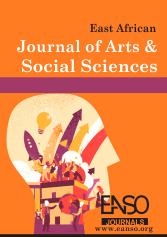Street Language and Social Survival in Gulu City: Insights from Aguu, the Socially Excluded Youth
Abstract
This paper examines the role of street language as a survival skill among the street children ‘Aguu’, a socially excluded youth in Gulu City, who continuously face stigmatization and discrimination in the community. The study used a qualitative research approach and historical design, involving participant observation, life history interviews and in-depth one-on-one oral interviews as data collection methods. Key findings from recent studies indicate that, over time, street language has emerged as a significant marker of social identity, particularly among marginalized and alienated groups. This linguistic phenomenon is especially prevalent among the youth, often derogatively referred to as "Aguu" by mainstream society. The study argues that street language fosters unity and identity among its speakers, acting as a form of resistance to societal exclusion. The study also contends that the culture of the youth, urbanization and post-conflict recovery have intensified and extended linguistic perspectives and forms of street communication, as economic and social transformations that reshape language use in Gulu City. This paper maintains that street language plays a crucial role as a means of identity and resilience for the socially excluded youth in Gulu City, as it allows them to navigate life on issues related to security, relationship-related inclusion, daily needs, conflict resolution, employment and medical needs. The paper concludes that the experiences of street children in Gulu City illustrate their resilience, adaptability, and determination to survive amidst systemic exclusion and societal neglect. Accordingly, the study recommends community-based support systems in order to create safe spaces and support networks for street children, provision of accessible and affordable mental health care and substance abuse counselling, as well as collaborative inclusive language and reduced stigma efforts to humanize experiences of these children, and foster greater community empathy and understanding within Gulu City. Above all, the study argues that both social institutions and government agencies should abandon the use of the term 'Aguu' to refer to street children, as it serves as a primary mechanism of social exclusion. This term, which has been adopted by both society and governmental bodies, carries derogatory connotations and reinforces the marginalization of these individuals
Downloads
References
Akkaya, Ö. & Yılgür, E. (2019). Locally Confined Territorial Stigmatization: The Case of “Gypsy” Stigma. İdealkent, 10(26), 214-253.
Amone, C., & Muura, O. (2014). British colonialism and the creation of Acholi ethnic identity in Uganda, 1894 to 1962. The Journal of Imperial and Commonwealth History, 42(2), 239-257.
Bajari, A., & Kuswarno, E. (2020). Violent language in the environment of street children singer-beggars. Heliyon, 6(8).
Blommaert, J. (2010). The Sociolinguistics of Globalization. Cambridge University Press.
Bourdieu, P. (1991). Language and symbolic power. Cambridge: Polity Press.
Bourdieu, P. (1991). Language and Symbolic Power. Polity. Harvard University Press.
Divon, S. A., & Owor, A. (2020). Aguu: From Acholi Post War Street Youth and Children to 'Criminal Gangs' in Modern Day Gulu City, Uganda. Journal of Human Security, 16(2), 82-96.
Eckert, P., & McConnell-Ginet, S. (1992). "Think Practically and Look Locally: Language and Gender as Community-Based Practice." Annual Review of Anthropology, 21, 461–490.
Eckert, P., & McConnell-Ginet, S. (1992). Think Practically and Globally: Language and Gender as Community-Based Practice. Annual Review of Anthropology, 21(1), 461-490.
Halliday, M. A. K. (2014). Language as social semiotic. The Discourse Studies Reader. Amsterdam: John Benjamins, 263-272.
Hirschfeld, L. A. (2018). The Rutherford atom of culture. Journal of Cognition and Culture, 18(3-4), 231-261.
Hoem, I. B. (2008). Women And Children At Risk: A Case Study Of Internally Displaced Persons From Waraffected Northern Uganda To Kampala City (Master's thesis, Norges teknisk-naturvitenskapelige universitet, Fakultet for samfunnsvitenskap og teknologiledelse, Geografisk institutt).
Human Rights Watch. (2003). Abducted and abused: Renewed conflict in Northern Uganda (Vol. 12). Human Rights Watch.
Kießling, R., & Mous, M. (2004). Urban youth languages in Africa. Anthropological Linguistics, 303-341.
Labov, W. (1972). Sociolinguistic Patterns. University of Pennsylvania Press.
Milroy, L., & Milroy, J. (1992). "Social Network and Social Class: Toward an Integrated Sociolinguistic Model." Language in Society, 21(1), 1-26.
Myers-Scotton, C. (1993). Duelling Languages: Grammatical Structure in Codeswitching. Oxford University Press.
Nassenstein, N. (2015). The emergence of Langila in Kinshasa (DR Congo). In N. Nassenstein & A. Hollington (Eds.), Youth language practices in Africa and beyond (pp. 81-98). Berlin: de Gruyter.a
Pennycook, A. (2007). Global Englishes and Transcultural Flows. Routledge.
Romaine, S. (2012). The bilingual and multilingual community. The Handbook of bilingualism and multilingualism, 443-465.
Situmorang, R. K., & Herman, H. (2021). An analysis of slang language styles used in Charlie’s Angels movie. Journal of English Educational Study (JEES), 4(1), 21-29.
Stejskalová, M. (2013). Can we speak of ghettos in Czech cities? Slovo, 25(2), 3-17.
Storch, A. (2011). Secret manipulations: Language and context in Africa. Oxford University Press.
Thomsen, T. M., & Bjerngaard, R. (2008). Beyond night commuting: Psychosocial needs among war affected children in Uganda. Nordic Psychology, 60(2), 87.
Trudgill, P. (2000). Sociolinguistics: An Introduction to Language and Society. Penguin Books.
Wenger, E. (1999). Communities of Practice: Learning, Meaning, and Identity. Cambridge University Press.
Copyright (c) 2025 Christopher John Omara, Agatha Alidri, Simon Okello, Patrick Ochen, Patrick Kabwijamu

This work is licensed under a Creative Commons Attribution 4.0 International License.




























